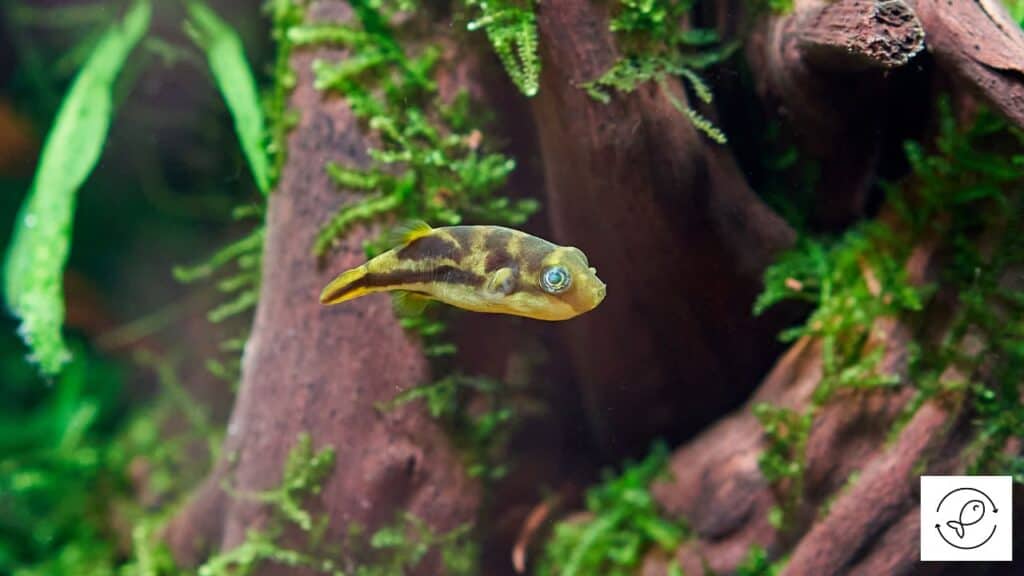Pea Puffers are small freshwater fish known for their personality and behavior. When adding tank mates, you need to consider the Pea Puffer’s semi-aggressive nature and need for a specific habitat.
Suitable tank mates include Pygmy Corydoras, Otocinclus Catfish, and small Tetras like the Glowlight and Ember varieties because they’re peaceful and similarly sized, reducing the chance of conflict.
Bristlenose Plecos can also live with Pea Puffers due to their protective armor. However, Cherry Shrimp are often eaten by Pea Puffers.
Careful planning and knowledge of how different species interact are vital for creating a peaceful aquarium with Pea Puffers.
1. Pygmy Cory
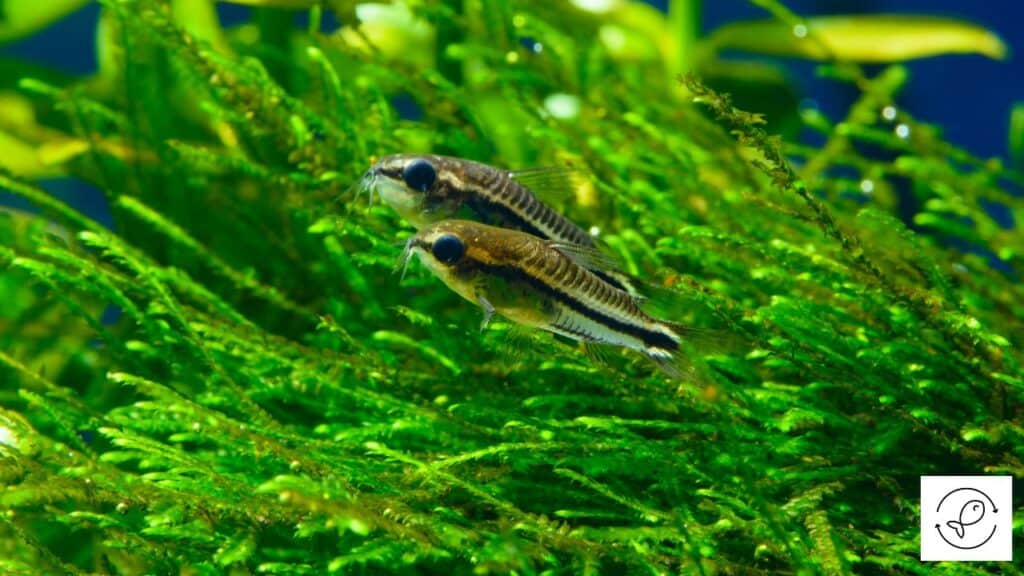
Pygmy Corys, or Pygmy Corydoras, are often chosen as tank mates for Pea Puffers due to their small size, typically 0.6 to 1 inch, and peaceful nature.
These fish are suitable for community tanks where they can coexist without triggering aggressive behavior in Pea Puffers. Pygmy Corys stay at the bottom of the aquarium, complementing the Pea Puffer’s preference for swimming in the mid to upper levels, which helps distribute fish activity evenly.
For their well-being, Pygmy Corys need established tanks with plenty of hiding places like driftwood, plants, and caves.
These refuges are crucial for their safety, especially when sharing space with more active fish like Pea Puffers. Pygmy Corys are social and should be kept in groups to reduce stress and maintain a clean substrate through their natural foraging.
2. Cherry Shrimp

Cherry Shrimp, also known as Neocaridina davidii, are small crustaceans that grow to an adult size of 1 to 2 inches.
They’re hardy and prefer water temperatures between 65°F to 85°F (18.3°C to 29.4°C). These conditions are also suitable for Pea Puffers, making Cherry Shrimp potential tank mates in a shared aquarium.
In a densely planted tank, Cherry Shrimp have numerous hiding spots which are essential for their survival, especially with Pea Puffers who may show aggressive behavior. Plants provide shelter for Cherry Shrimp to safely feed on biofilm.
However, there is a risk of nipping by Pea Puffers, which may harm the Cherry Shrimp if there isn’t enough cover. A well-planted aquarium with many hiding places is crucial for the Cherry Shrimp’s well-being when kept with Pea Puffers.
You should carefully observe the interactions between Cherry Shrimp and Pea Puffers to ensure a peaceful environment. Monitoring the Pea Puffer’s behavior toward Cherry Shrimp is crucial for maintaining a healthy community tank.
3. Glowlight Tetra
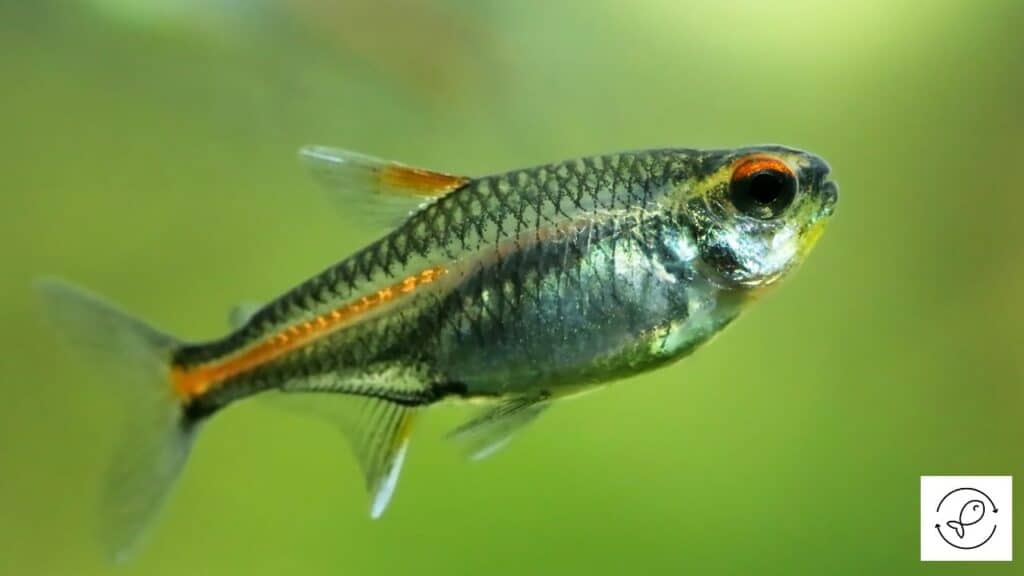
Glowlight Tetras are compatible with peaceful aquatic species and can coexist with Pea Puffers in a community tank.
They have a distinctive orange-red stripe and are known for their peaceful behavior. These fish are suitable companions for Pea Puffers due to their non-aggressive nature and similar size.
Glowlight Tetras can balance the more active personality of Pea Puffers. They typically school together, creating a visual contrast with the Pea Puffers.
A minimum tank size of 5 to 10 gallons is recommended for a group of Glowlight Tetras, which is also sufficient for Pea Puffers, allowing both species enough space to avoid competition and stress.
You need to match the adult size of Glowlight Tetras, which is between 0.8 to 2 inches, with Pea Puffers to prevent predation. Proper water conditions are essential, with a temperature range of 64°F to 82°F (17.8°C to 27.8°C) being ideal.
A tank with hiding places and plants benefits both species by simulating their natural habitats and providing an enriched environment.
4. Neon Tetra
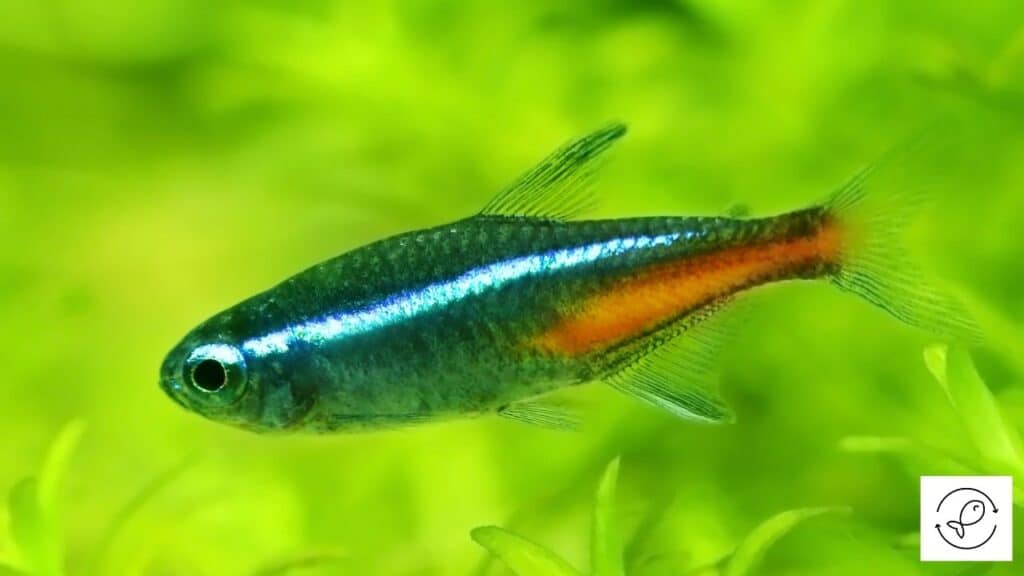
Neon Tetras, scientifically known as Paracheirodon innesi, are a popular choice for community aquariums due to their bright blue and red colors. They’re small, peaceful fish, typically measuring between 0.8 to 2 inches, and can be kept with Pea Puffers.
Neon Tetras prefer water temperatures between 64°F to 82°F (17.8°C to 27.8°C), which suits Pea Puffer habitats well.
It’s recommended to keep Neon Tetras in groups of six or more since they’re schooling fish. This behavior not only reduces stress but also creates an attractive visual as they swim together.
Proper tank conditions include a space of at least 5 to 10 gallons to accommodate their need for swimming and a mix of hiding places and open areas.
This setup helps prevent territorial behavior and allows for a healthy coexistence between Neon Tetras and Pea Puffers.
5. Killifish

Killifish are suitable companions for Pea Puffers due to their small size of 1 to 3 inches and their non-aggressive behavior.
They’re compatible with Pea Puffers in a peaceful aquarium setting and contribute to visual diversity. In a tank of at least 20 gallons, Killifish can coexist with Pea Puffers if the water temperature is kept between 72°F to 75°F (22.2°C to 23.9°C), which suits both species.
Killifish adapt well to different water conditions and generally get along with other fish, making them a good choice for community tanks. You should observe their interactions with Pea Puffers initially as they can have varying temperaments.
6. Panda Cory

The Panda Cory, scientifically known as Corydoras panda, is a small, peaceful fish that is well-suited for community aquariums with Pea Puffers.
They grow to be about 0.6 to 2 inches long and are ideal for small aquariums. Panda Corys can live in a range of water conditions, with temperatures from 68°F to 82°F (20°C to 27.8°C), making them compatible with Pea Puffers.
These fish are non-aggressive and can share the bottom of the tank with other species without conflict, helping to keep the substrate clean.
They need hiding places and vegetation in their habitat for their well-being. Panda Corys are appropriate for aquariums between 8 to 20 gallons, accommodating the space needs of both them and Pea Puffers.
Having Panda Corys as tank mates contributes to a diverse and stable aquarium community.
7. Amano Shrimp

Amano Shrimp (Caridina multidentata) are suitable tank mates for Pea Puffers due to their peaceful behavior and similar water condition requirements.
These shrimp typically grow to 1 to 2 inches and can comfortably share a small tank, with a minimum size of 5 gallons, with Pea Puffers.
As efficient algae eaters, Amano Shrimp help keep the aquarium clean by feeding on algae and waste. They’re particularly useful in planted tanks, which Pea Puffers also enjoy for the hiding spaces they provide.
Amano Shrimp can live in a temperature range of 65°F to 85°F (18.3°C to 29.4°C), matching the Pea Puffer’s needs and making tank maintenance easier.
However, a well-planted tank with plenty of hiding spots is important to mimic their natural environment, minimize stress, and avoid conflict.
8. Bloodfin Tetra
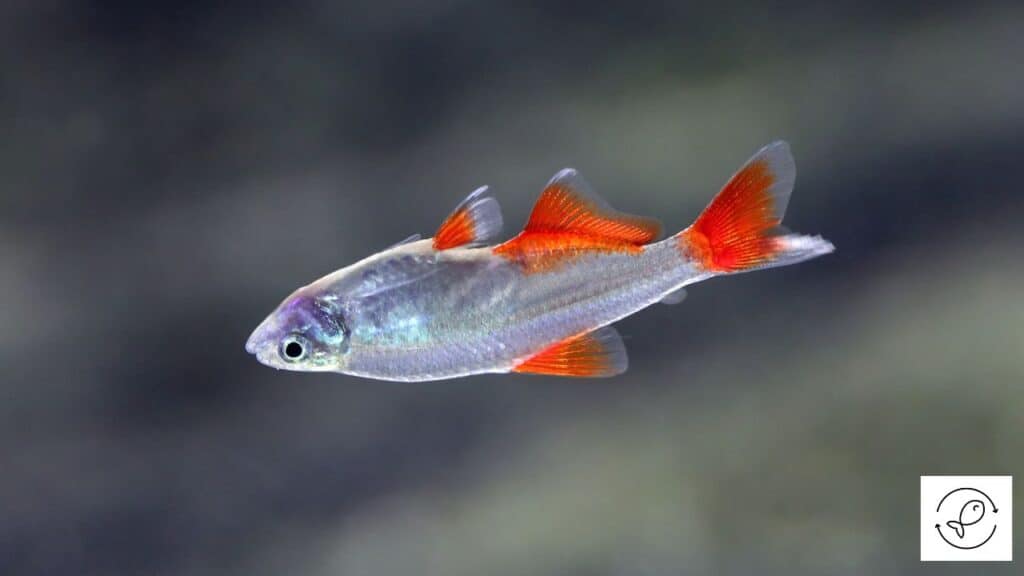
Bloodfin Tetras, scientifically called Aphyocharax Anisitsi, are small fish that grow to about 0.8 to 2 inches. They can adapt to water temperatures ranging from 64°F to 82°F (17.8°C to 27.8°C), which suits the needs of Pea Puffers.
The recommended minimum tank size for Bloodfin Tetras is 5 to 10 gallons. When housed with Pea Puffers, you need to have enough plants and hiding spots to prevent conflicts and ensure a peaceful environment.
Bloodfin Tetras are known for their peaceful nature and can generally coexist with many fish, including Pea Puffers.
However, the success of this cohabitation depends on proper tank setup with ample space and hiding areas to reduce territorial behavior, as Pea Puffers can sometimes be aggressive.
You need to monitor the behavior of Bloodfin Tetras and Pea Puffers when they’re first introduced as tank mates to ensure they’re compatible. With the right conditions, both species can thrive together, contributing to a diverse and attractive aquarium.
9. Siamese Algae Eater
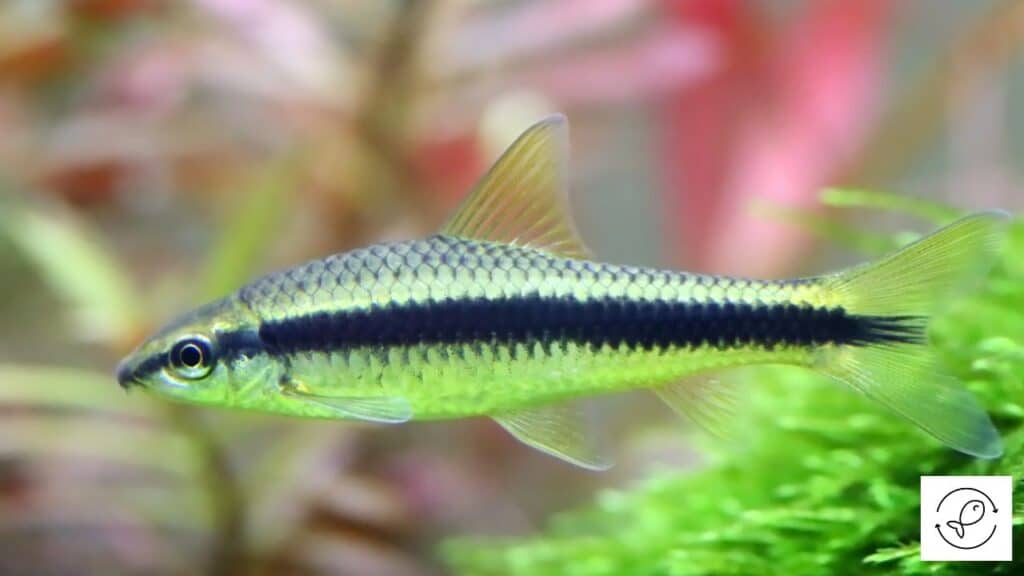
Siamese Algae Eaters (Crossocheilus oblongus) are suitable companions for Pea Puffers. They’re peaceful fish that grow up to 6 inches, requiring at least a 20-gallon tank.
These fish help control algae, which keeps the aquarium clean. They eat various algae types, especially hair algae.
Despite their algae-eating habits, Siamese Algae Eaters need a balanced diet that includes sinking pellets, flakes, and occasional live or frozen food to stay healthy. They can share the space with smaller algae eaters such as Otocinclus Catfish without competing for food due to their size difference.
Siamese Algae Eaters are a good match for Pea Puffers if they have enough space and a varied diet. They not only manage algae but also contribute to a balanced aquarium environment.
10. Kuhli Loach
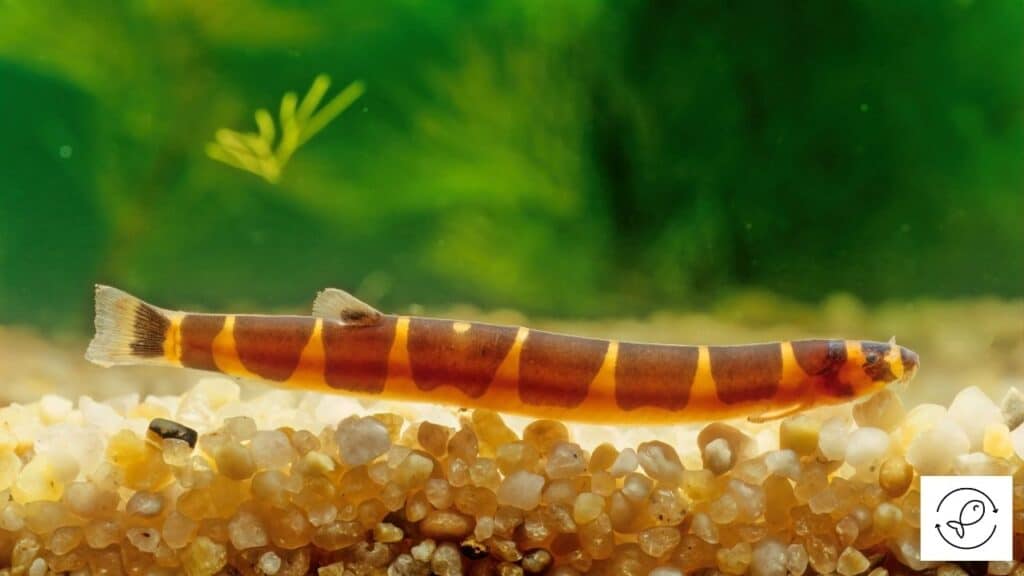
Kuhli Loaches are peaceful fish that can coexist with Pea Puffers in an aquarium. These fish, belonging to the genus Pangio, have a calm nature and can get along with various species, including the slightly territorial Pea Puffers.
Kuhli Loaches have thin, eel-like bodies and are known to be active, adding to the diversity of life in a community tank.
These loaches typically grow to be between 0.6 to 4 inches long, which makes them suitable tank mates for Pea Puffers concerning space. It’s recommended to have at least a 20-gallon tank for these species to live together comfortably, providing enough room for both to establish their own territories.
Kuhli Loaches adapt well to a range of water conditions and do well in temperatures that Pea Puffers also prefer, which are between 68°F to 82°F (20°C to 27.8°C).
Aquariums housing both Kuhli Loaches and Pea Puffers should include numerous hiding spots.
Kuhli Loaches are nocturnal and need places like caves, driftwood, and thick plants to hide, which suits their natural behavior and reduces stress. This also helps prevent conflicts with other fish.
11. Guppy
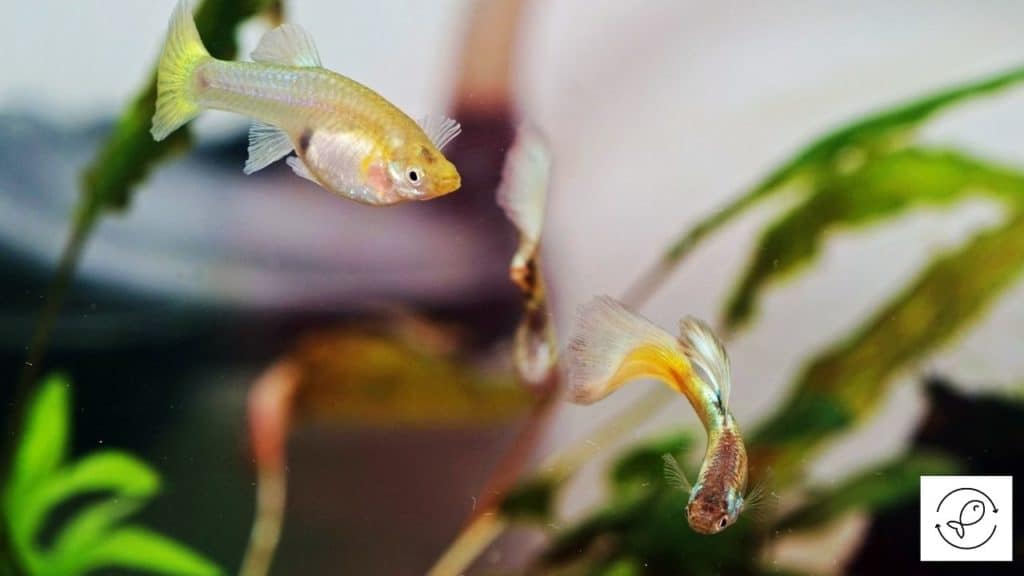
Guppies, or Poecilia reticulata, are suitable companions for Pea Puffers in an aquarium due to their calm nature and similar size.
They thrive in a 5 to 10-gallon tank with water temperatures between 64°F to 82°F (17.8°C to 27.8°C), which is also suitable for Pea Puffers. Adult Guppies grow to 0.8 to 2 inches, making them non-threatening to the smaller Pea Puffer.
Guppies aren’t aggressive and can coexist peacefully with Pea Puffers. Their active swimming style is compatible with the Pea Puffers’ behavior.
It’s advised not to house them with long-finned species like Bettas, which Pea Puffers may nip at, causing harm. Guppies don’t have such long fins, reducing this risk.
12. Platy Fish
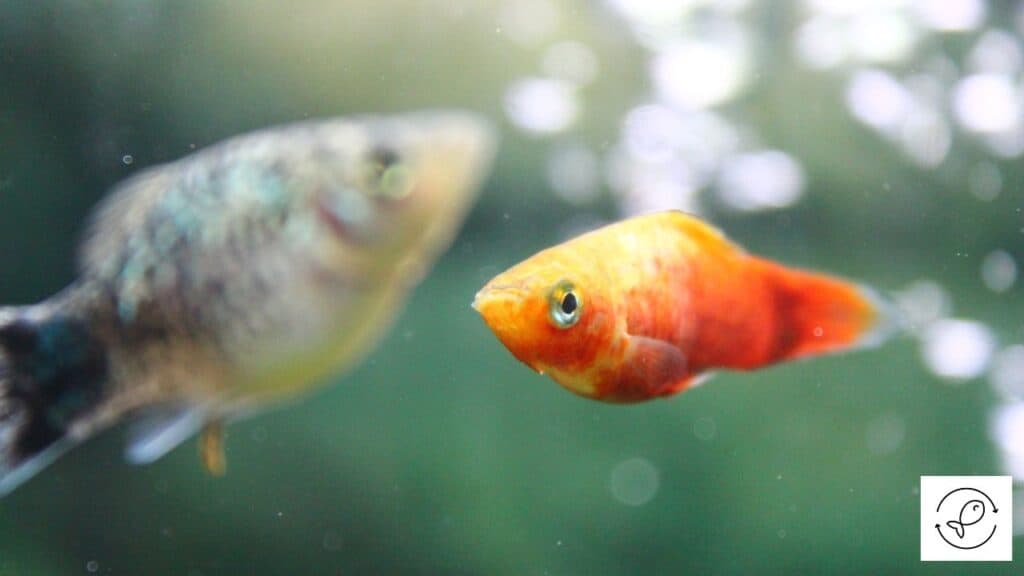
Platies are a suitable choice for a Pea Puffer tank due to their peaceful nature and size, which typically ranges from 0.8 to 2 inches. They pose no threat to Pea Puffers and aren’t easily targeted by them.
Originating from tropical climates, Platies adapt well to community tanks.
Water parameter compatibility is important when pairing tank mates with Pea Puffers. Platies can live in a temperature range of 64°F to 82°F (17.8°C to 27.8°C), similar to the Pea Puffers’ preferred conditions, making it easier to maintain a shared tank environment.
Their non-aggressive behavior is less likely to trigger territorial responses from Pea Puffers.
For cohabitation, a minimum tank size of 10 gallons is necessary to provide enough space for swimming and territory establishment, which helps minimize stress and aggression. A well-structured tank with hiding spots and plants allows Pea Puffers and Platy Fish to coexist peacefully.
Platies add to the tank’s visual appeal with their colorful appearance and calm demeanor, contributing to a balanced and engaging aquarium ecosystem.
13. Corydoras Catfish
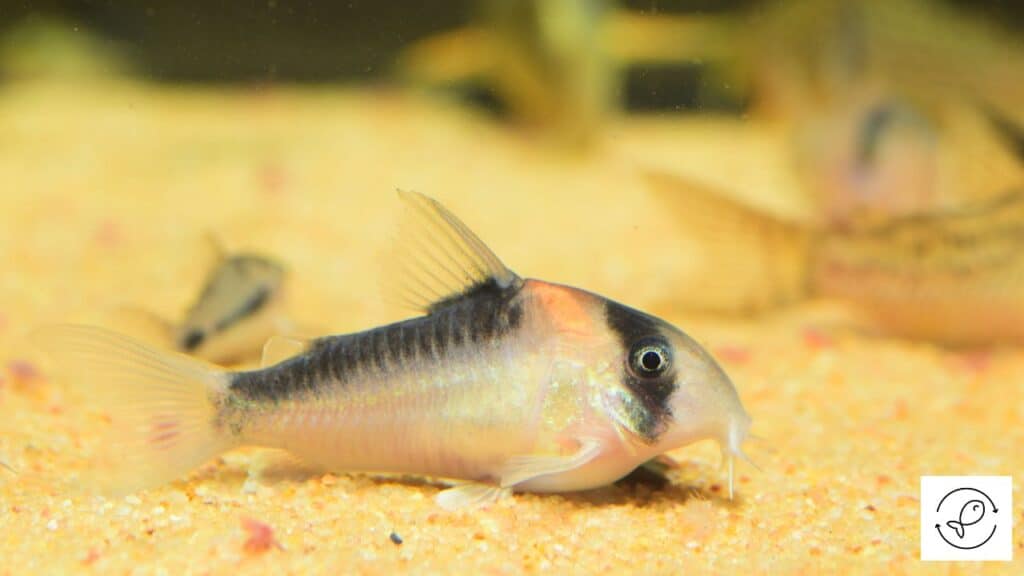
Corydoras Catfish are peaceful and make good tank mates for Pea Puffers in community aquariums. They’re active bottom dwellers and non-aggressive, creating a balanced environment.
It’s essential to provide a tank large enough for both Corydoras Catfish and Pea Puffers to coexist comfortably, considering their space needs and territorial behavior.
Corydoras Catfish adapt to various water temperatures and need a tank size suitable for their species. They play a vital role as bottom feeders, consuming leftover food and helping maintain a clean tank.
These fish are a popular choice for community tanks due to their peaceful nature and small size. They can live with many fish species.
For a tank with Pea Puffers, Corydoras Catfish are recommended for their easygoing nature and their contrast to the Pea Puffers’ swimming patterns.
14. Molly Fish
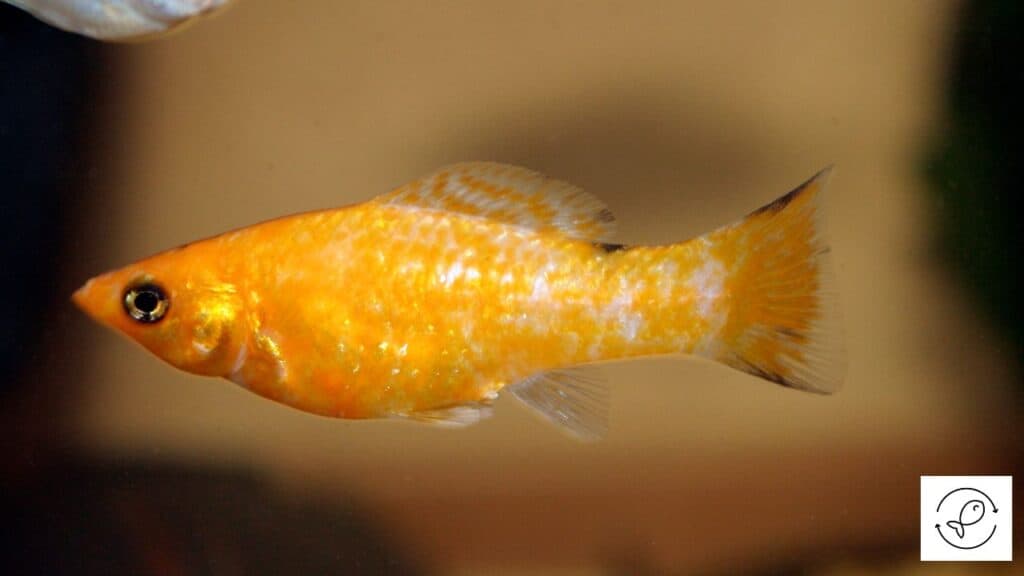
Mollies are known for their calm nature and are compatible with many fish species, including Pea Puffers in community aquariums. They belong to the genera Poecilia sphenops and Poecilia velifera and can peacefully coexist with the sometimes territorial Pea Puffers.
Mollies are livebearers, meaning they give birth to live young, which can add interest to an aquarium and interact with Pea Puffers. These fish are adaptable to a range of water conditions, thriving in temperatures between 64°F to 82°F (17.8°C to 27.8°C), suitable for Pea Puffers as well.
However, you should provide enough space for Mollies to swim freely. A minimum tank size of 5 to 10 gallons is necessary, with larger tanks being better to avoid stress and aggression due to overcrowding.
For a well-rounded community aquarium, consider adding other peaceful fish such as Kuhli Loach (Pangio kuhlii), Corydoras Catfish, or Zebra Danio (Danio rerio). These species can share the environment without causing stress, allowing all fish, including Mollies and Pea Puffers, to behave naturally.
15. Chili Rasboras
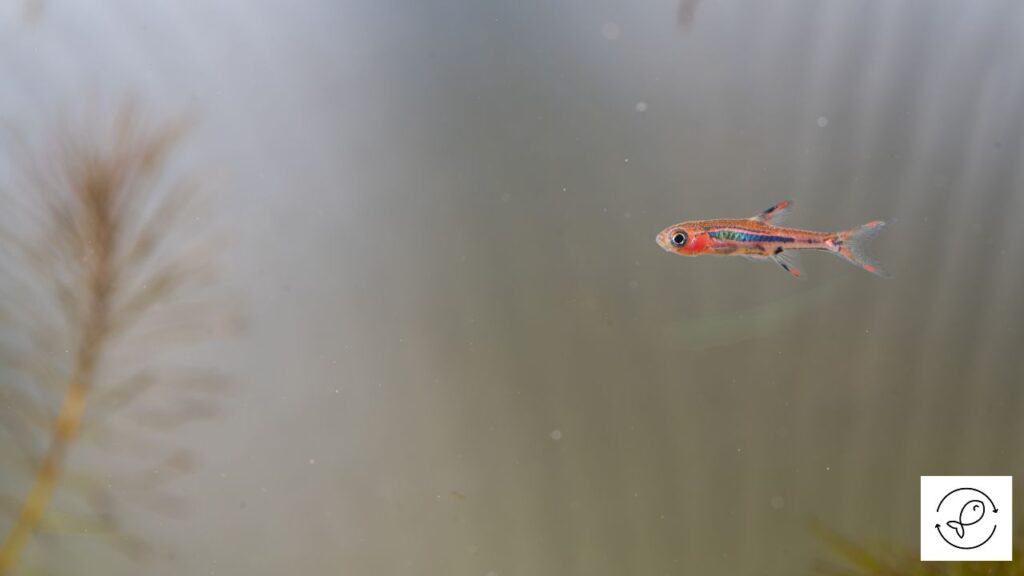
Chili Rasboras (Boraras brigittae) are a suitable option for a community aquarium with Pea Puffers due to their small size, vibrant color, and peaceful temperament. These fish typically grow to 0.6 to 1.4 inches in length.
They’re compatible with Pea Puffers as both species are small and non-aggressive.
Chili Rasboras have a distinctive red color that adds visual appeal to a tank containing less colorful Pea Puffers. Both species are omnivores and can share a common diet, making feeding routines easier to manage.
For optimal cohabitation, an aquarium should have abundant plants and hiding spaces to mimic the natural habitat of the Chili Rasboras and provide Pea Puffers with areas to explore. A well-planted tank also helps maintain water quality, essential for the health of both species.
16. White Cloud Mountain Minnow

White Cloud Mountain Minnows (Tanichthys albonubes) are suitable companions for Pea Puffers in community aquariums. These small fish reach adult sizes of 0.8 to 2 inches, fitting well with Pea Puffers.
They’re known for their peaceful behavior and can coexist with many fish species, including Pea Puffers.
These minnows share similar water temperature preferences with pea puffers, ranging from 64°F to 82°F (17.8°C to 27.8°C), and aren’t aggressive.
They need a minimum of a 5 to 10-gallon tank, which is also suitable for Pea Puffers. Their calm nature prevents competition over food or territory, promoting a stable aquarium environment.
White Cloud Mountain Minnows act as dither fish, encouraging shy Pea Puffers to be more active, thus enhancing tank activity and aesthetics.
They’re also easy to care for, adaptable, and can tolerate a variety of water conditions. This makes them a good choice for both new and experienced fish keepers who want to maintain a peaceful community aquarium.
17. Zebra Danio
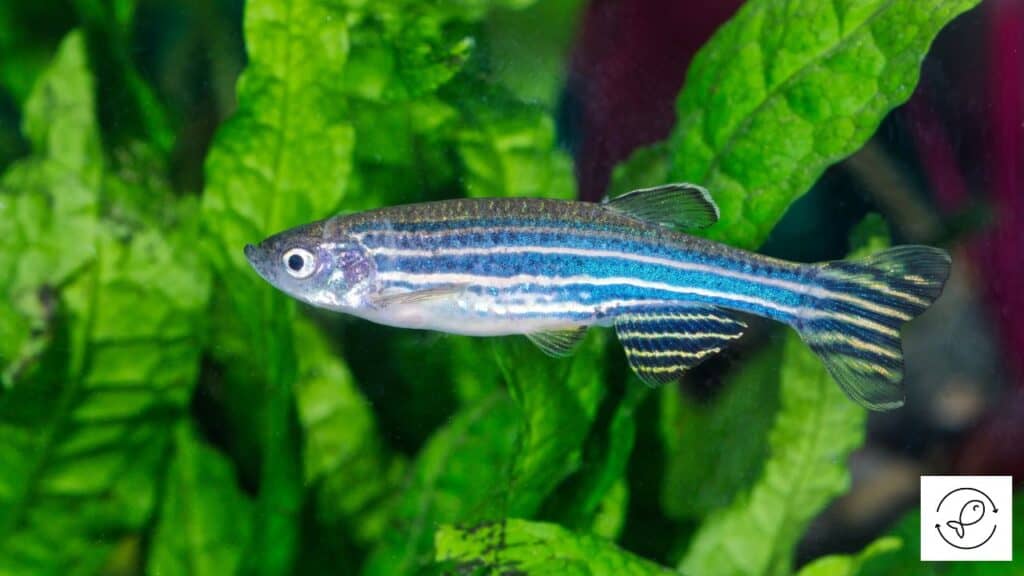
Zebra Danios (Danio rerio) are suitable tank mates for Pea Puffers due to their peaceful nature and adaptability to different water conditions. These fish, which grow to an adult size of 0.8 to 2 inches, can live with Pea Puffers in a minimum tank size of 5 to 10 gallons, allowing enough space for both species.
Known for their resilience, Zebra Danios can tolerate a variety of temperatures, making them a practical addition to a community aquarium. Their distinctive stripes and quick swimming can divert Pea Puffers from nipping at slower or long-finned fish.
You must keep Zebra Danios in groups, as they’re schooling fish and display more interesting behaviors when in numbers. Their non-aggressive nature contributes to a peaceful community tank.
For an aquarium with both Zebra Danios and Pea Puffers, maintain a well-kept environment with ample hiding places and vegetation to support a healthy and interactive ecosystem.
18. Otocinclus Catfish
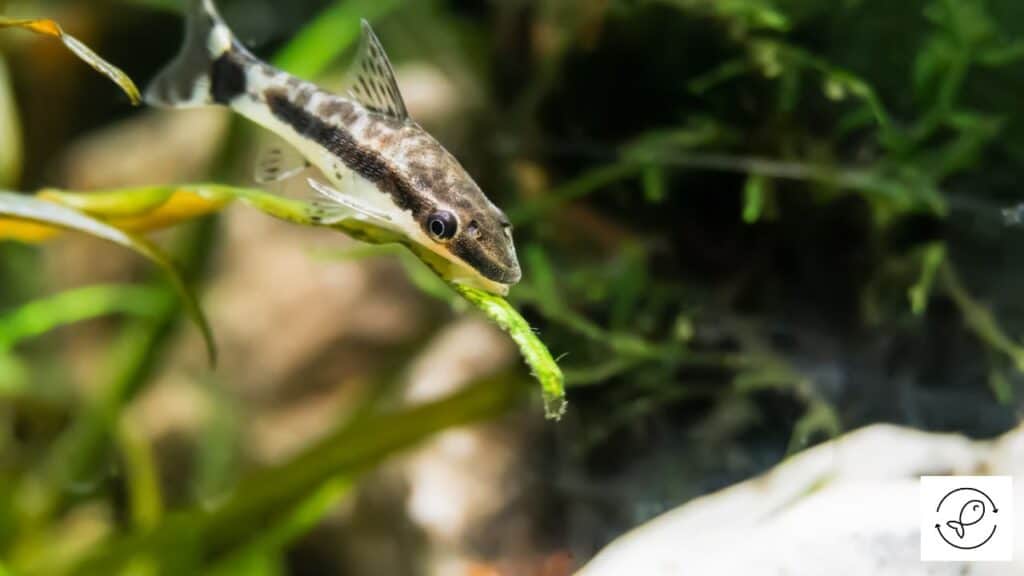
Otocinclus Catfish are suitable tank mates for Pea Puffers due to their peaceful behavior and shared water condition requirements. Adding Otocinclus Catfish to a Pea Puffer tank is likely to be successful as they’re non-aggressive and help maintain cleanliness by eating algae.
Otocinclus Catfish are small, growing between 0.6 to 4 inches, making them a good size for a tank with Pea Puffers. They need a minimum tank size of 8 to 20 gallons, which is compatible with the space needs of Pea Puffers.
In a shared tank, Otocinclus Catfish perform their cleaning tasks without disrupting other fish. Their calm nature prevents territorial conflicts, which is vital when housing them with Pea Puffers that can be territorial.
Otocinclus Catfish are an excellent choice for aquarium owners looking to establish a tranquil and diverse environment in a Pea Puffer tank. They contribute to a cleaner tank and can coexist with Pea Puffers without issues.
19. Bristlenose Pleco
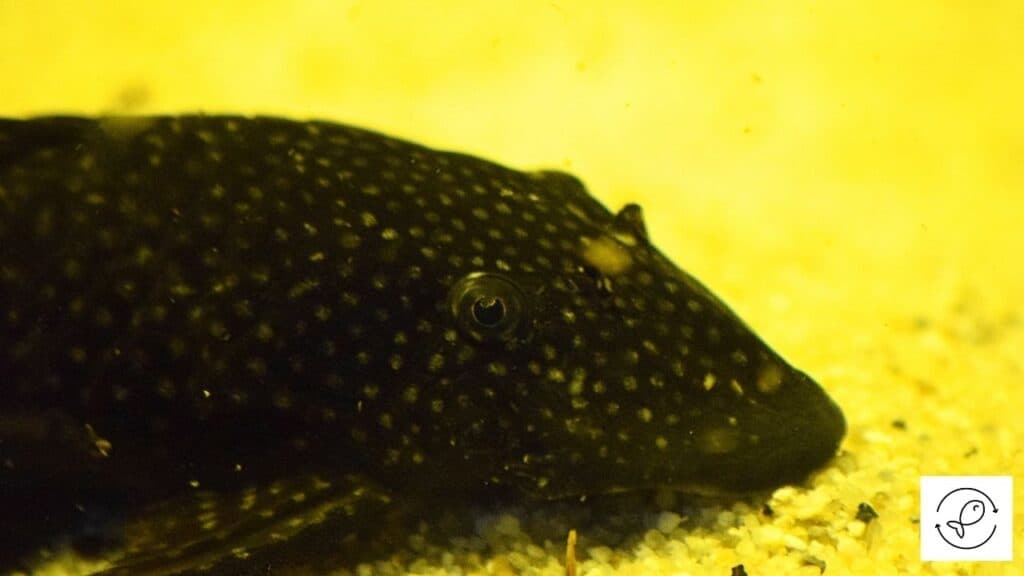
Bristlenose Plecos, known as Ancistrus cirrhosus, are suitable tank mates for Pea Puffers due to their calm nature and helpfulness in cleaning the tank. They grow to 4 to 5 inches and need at least a 20-gallon tank to prevent territorial issues.
Compatibility depends on the Pea Puffers’ behavior, which can vary. Pea Puffers may show aggression, but Bristlenose Plecos usually avoid conflict and focus on eating algae and leftover food. This behavior contributes to a clean and healthy aquarium.
Both species need water temperatures between 73°F to 80°F (22.8°C to 26.7°C). Monitoring their interactions is necessary to ensure a peaceful environment.
With proper tank setup, including hiding places and the correct diet, Bristlenose Plecos can coexist with Pea Puffers, adding to the visual appeal and health of the tank.
20. Ember Tetra
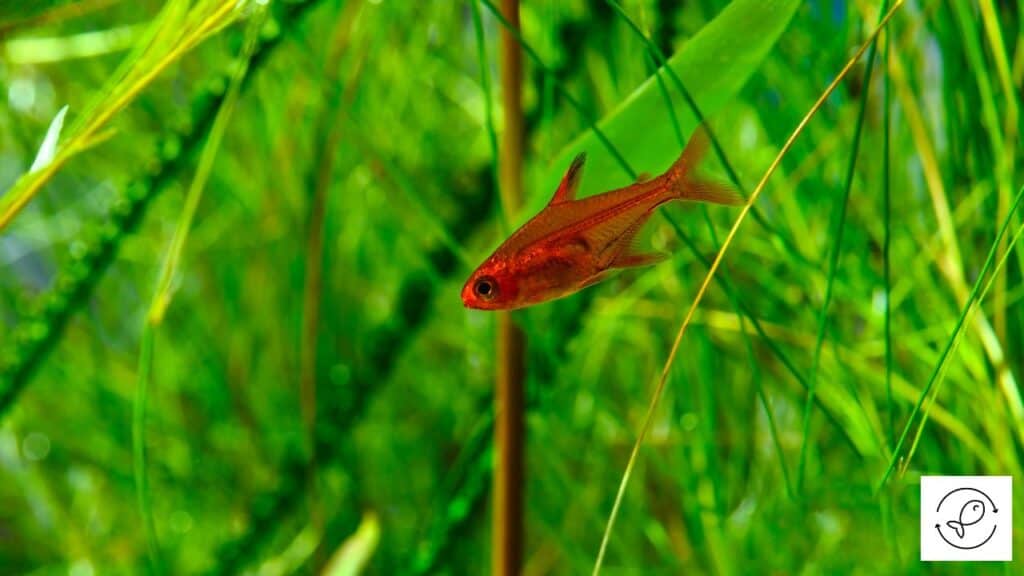
Ember Tetras, known scientifically as Hyphessobrycon amandae, are small, vibrant fish that can coexist with Pea Puffers in aquariums. They grow to be about 0.8 to 2 inches and are suitable for community tanks due to their peaceful nature.
To maintain the health of both Ember Tetras and Pea Puffers, the water temperature should be kept between 64°F to 82°F (17.8°C to 27.8°C), and the aquarium should be at least 5 to 10 gallons to avoid stress and competition for space.
A well-planted tank is beneficial as it provides hiding spots and mimics their natural environment.
Although Ember Tetras are peaceful, they can cohabit with the sometimes territorial Pea Puffers, potentially reducing aggression in the tank. However, you need to watch for any aggressive behavior from Pea Puffers, such as fin-nipping.

